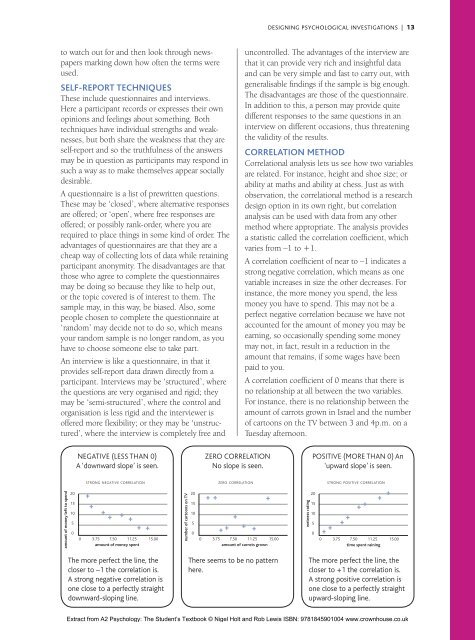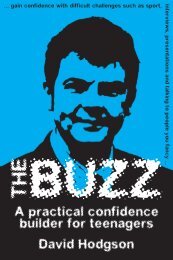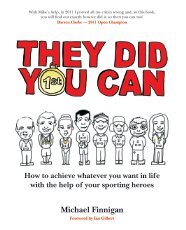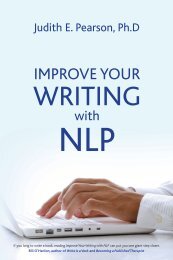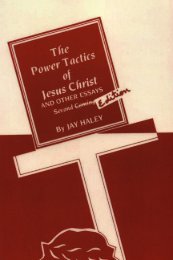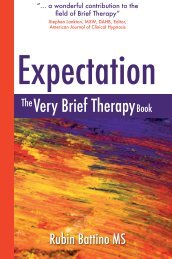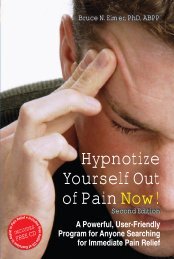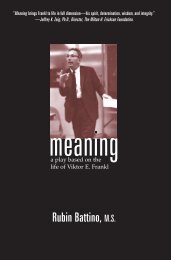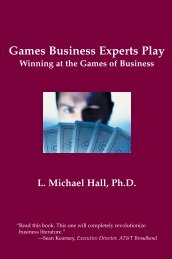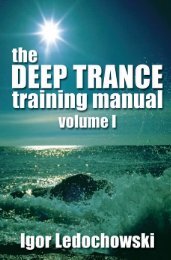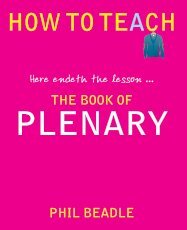Nigel Holt and Rob Lewis - Crown House Publishing.
Nigel Holt and Rob Lewis - Crown House Publishing.
Nigel Holt and Rob Lewis - Crown House Publishing.
You also want an ePaper? Increase the reach of your titles
YUMPU automatically turns print PDFs into web optimized ePapers that Google loves.
DESIGNING PSYCHOLOGICAL INVESTIGATIONS | 13to watch out for <strong>and</strong> then look through newspapersmarking down how often the terms wereused.Self-report techniquesThese include questionnaires <strong>and</strong> interviews.Here a participant records or expresses their ownopinions <strong>and</strong> feelings about something. Bothtechniques have individual strengths <strong>and</strong> weaknesses,but both share the weakness that they areself-report <strong>and</strong> so the truthfulness of the answersmay be in question as participants may respond insuch a way as to make themselves appear sociallydesirable.A questionnaire is a list of prewritten questions.These may be ‘closed’, where alternative responsesare offered; or ‘open’, where free responses areoffered; or possibly rank-order, where you arerequired to place things in some kind of order. Theadvantages of questionnaires are that they are acheap way of collecting lots of data while retainingparticipant anonymity. The disadvantages are thatthose who agree to complete the questionnairesmay be doing so because they like to help out,or the topic covered is of interest to them. Thesample may, in this way, be biased. Also, somepeople chosen to complete the questionnaire at‘r<strong>and</strong>om’ may decide not to do so, which meansyour r<strong>and</strong>om sample is no longer r<strong>and</strong>om, as youhave to choose someone else to take part.An interview is like a questionnaire, in that itprovides self-report data drawn directly from aparticipant. Interviews may be ‘structured’, wherethe questions are very organised <strong>and</strong> rigid; theymay be ‘semi-structured’, where the control <strong>and</strong>organisation is less rigid <strong>and</strong> the interviewer isoffered more flexibility; or they may be ‘unstructured’,where the interview is completely free <strong>and</strong>uncontrolled. The advantages of the interview arethat it can provide very rich <strong>and</strong> insightful data<strong>and</strong> can be very simple <strong>and</strong> fast to carry out, withgeneralisable findings if the sample is big enough.The disadvantages are those of the questionnaire.In addition to this, a person may provide quitedifferent responses to the same questions in aninterview on different occasions, thus threateningthe validity of the results.Correlation methodCorrelational analysis lets us see how two variablesare related. For instance, height <strong>and</strong> shoe size; orability at maths <strong>and</strong> ability at chess. Just as withobservation, the correlational method is a researchdesign option in its own right, but correlationanalysis can be used with data from any othermethod where appropriate. The analysis providesa statistic called the correlation coefficient, whichvaries from –1 to +1.A correlation coefficient of near to –1 indicates astrong negative correlation, which means as onevariable increases in size the other decreases. Forinstance, the more money you spend, the lessmoney you have to spend. This may not be aperfect negative correlation because we have notaccounted for the amount of money you may beearning, so occasionally spending some moneymay not, in fact, result in a reduction in theamount that remains, if some wages have beenpaid to you.A correlation coefficient of 0 means that there isno relationship at all between the two variables.For instance, there is no relationship between theamount of carrots grown in Israel <strong>and</strong> the numberof cartoons on the TV between 3 <strong>and</strong> 4p.m. on aTuesday afternoon.NEGATIVE (LESS THAN 0)A ‘downward slope’ is seen.ZERO CORRELATIONNo slope is seen.POSITIVE (MORE THAN 0) An‘upward slope’ is seen.amount of money left to spend20151050STRONG NEGATIVE CORRELATION++++ + ++ +0 3.75 7.50 11.25 15.00amount of money spentnumber of cartoons on TV20151050ZERO CORRELATION+ ++++ + + +0 3.75 7.50 11.25 15.00amount of carrots grownwetness rating20151050STRONG POSITIVE CORRELATION+ + + ++ + + +0 3.75 7.50 11.25 15.00time spent rainingThe more perfect the line, thecloser to –1 the correlation is.A strong negative correlation isone close to a perfectly straightdownward-sloping line.There seems to be no patternhere.The more perfect the line, thecloser to +1 the correlation is.A strong positive correlation isone close to a perfectly straightupward-sloping line.Extract from A2 Psychology: The Student’s Textbook © <strong>Nigel</strong> <strong>Holt</strong> <strong>and</strong> <strong>Rob</strong> <strong>Lewis</strong> ISBN: 9781845901004 www.crownhouse.co.uk


